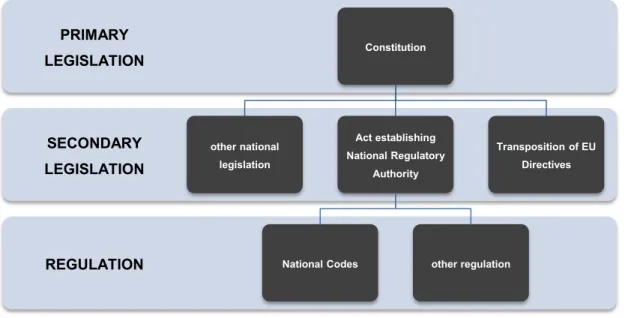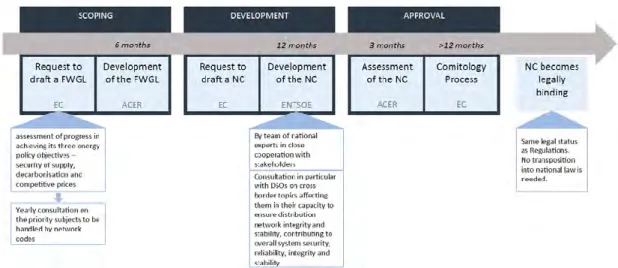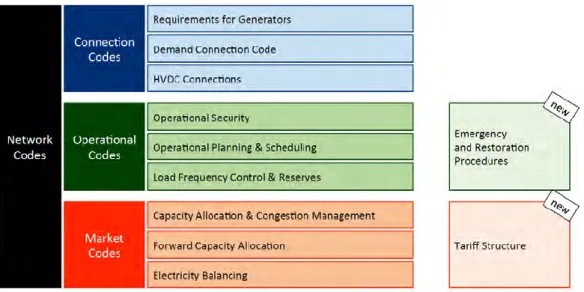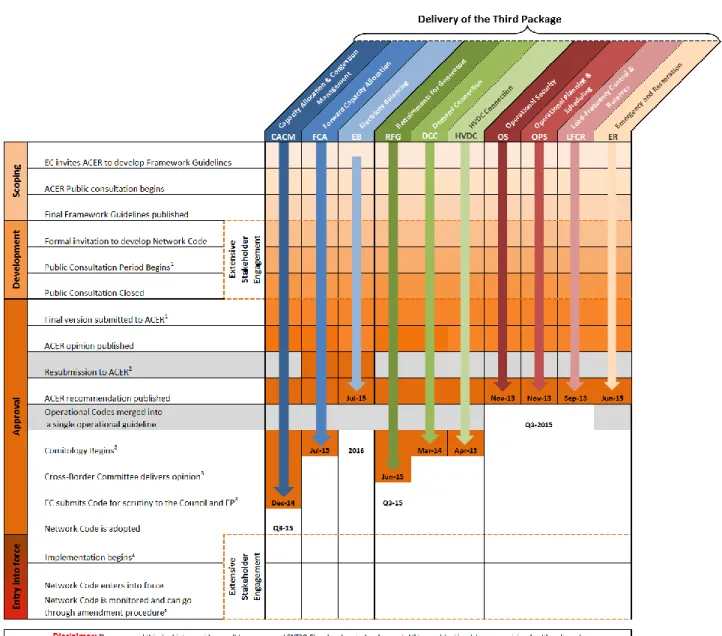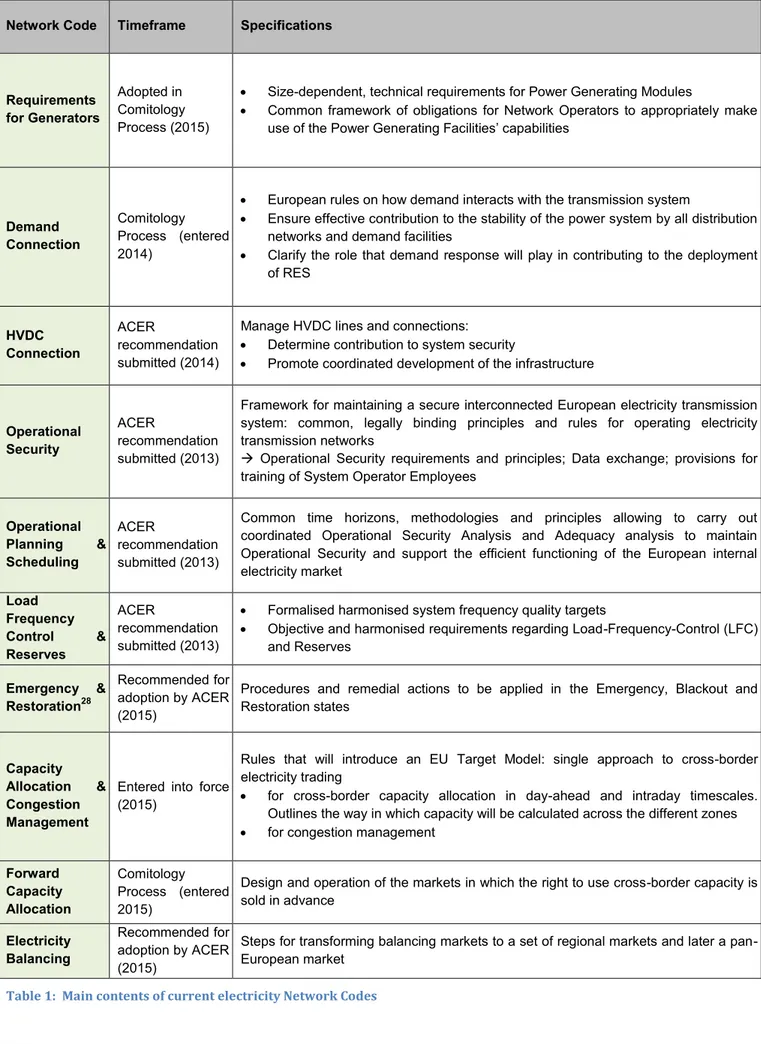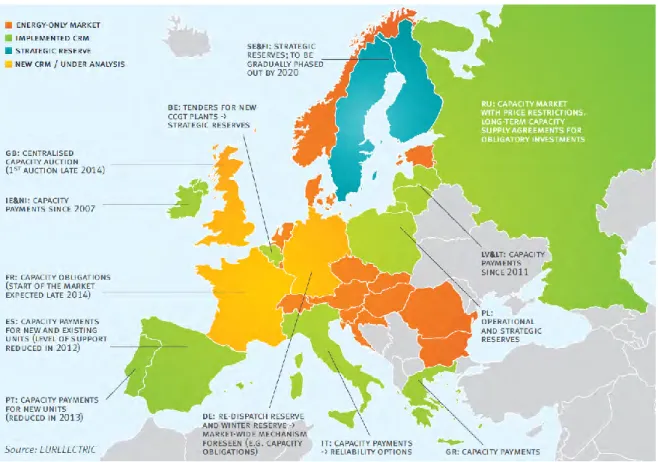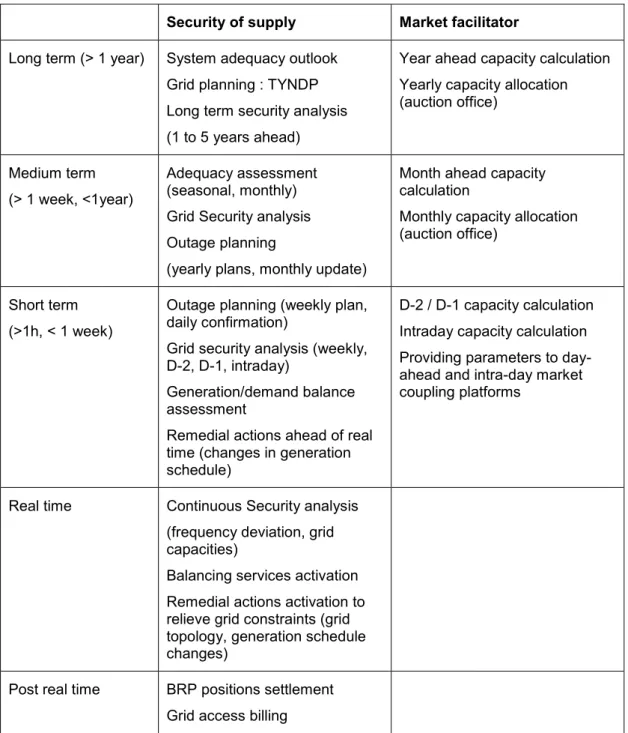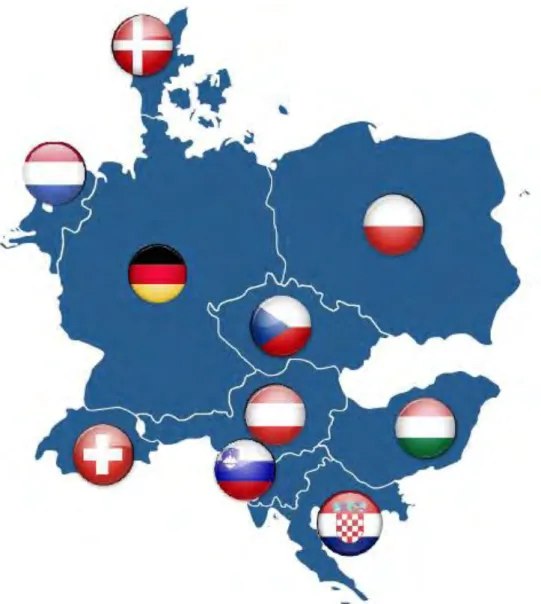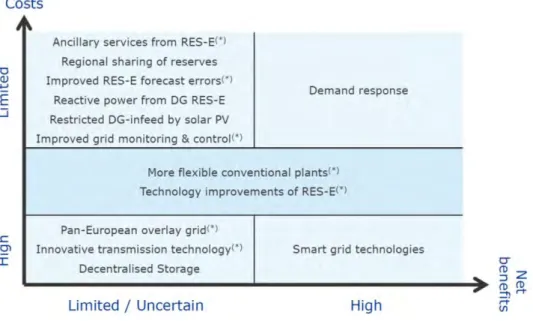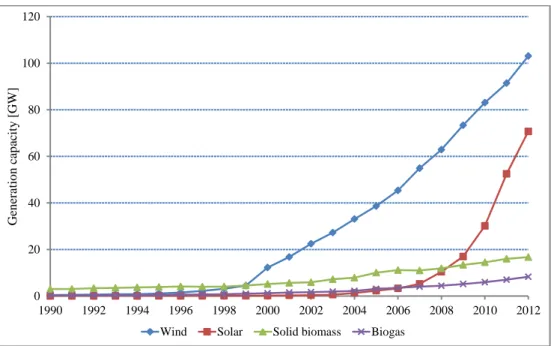FLORENCE SCHOOL OF REGULATION
RESEARCH
ISBN:978-92-9084-343-6REPORT
doi:10.2870/80798A conceptual framework
for the evolution of the
operation and regulation
of electricity transmission
systems towards a
decarbonised and
increasingly integrated
electricity system in the EU
Authors: Jean-Michel Glachant, Jorge
Vasconcelos and Vincent Rious
Executive Summary
The electricity industry is undergoing major changes mainly dictated by the need to simultaneously accomplish integration of European energy markets and build a low‐carbon economy. This process was facilitated if not initiated by a wave of technological innovation. In order to ensure a timely, orderly and efficient transition towards the new low-carbon landscape the present legal and regulatory frameworks, devised long ago, must be reviewed and adapted in order to provide adequate rules and suitable incentives.
The purpose of this report is to help relevant stakeholders to take a leading role in transforming the way electricity systems are managed and operated in order to meet the twin targets of decarbonisation and increased market integration in the most efficient way. Because there are many uncertainties and some degrees of freedom as regards policy choices and their implementation, diverse future scenarios are conceivable. Instead of selecting one scenario and suggesting a mandatory approach, this report offers:
a) A conceptual framework to assess and compare different options, showing the impact of different structural changes upon governance and regulation of electricity systems and markets.
b) Useful checkpoints and recommendations aimed at safeguarding the internal coherence of any selected scenario.
Although several alternative paths may lead to decarbonisation and integration of present electricity systems, each path presents its own governance and regulatory challenges and it commands specific actions. Decision-makers are free to favour, endorse or even determine any given “feasible” political or technological path. However, once they have taken this primordial decision, their subsequent choices should be compatible with objective - and unfortunately complex - technical, economic and institutional constraints of electricity systems and markets. Any lack of internal consistency will make energy transition unnecessarily costly and protracted. The main goal of this report is to help decision-makers steering energy transition along a coherent course.
The transition towards low-carbon energy systems requires not only new rules, but also new roles. In particular, the role of transmission networks and the role of transmission system operators are changing and need to evolve even faster over the coming years. Given the different time-scales for investments in generation and in networks, any successful energy transition wishing to preserve current reliability standards requires timely and coherent adjustments of the role played by Transmission System Operators (TSOs). The recommendations provided take into account the need to ensure a dynamic balance between the “creative destruction” of market forces and technological innovation, on the one hand, and the intrinsic stringency of power system reliability governance, on the other hand.
In order to better grasp some structural novelties of the new world we are entering in and to identify major critical issues, the report first introduces three basic conceptual scenarios:
- Lower decarbonization within a pan-European system
- Higher decarbonization within existing Member State systems - Higher decarbonization within decentralized systems
They correspond to three “ideal types” (extreme scenarios), not to “most likely outcomes”. It is assumed that reality will most probably be a combination of these three basic scenarios. Hybridation
may happen “by design” (i.e., because decision-makers consciously opt for a hybrid model) or “by accident” (i.e., because decisions being taken by different agents at different places and at different points in time result in a dynamic hybrid outcome that does not correspond to the expected outcome of any individual agent).
For each scenario, the report discusses in detail how the main functions and interactions of European TSOs need to change and how these changes differ between the three scenarios. The report analyses both the “hardware side” and the “software side”:
- The “hardware” side means network planning, building infra-structure assets, managing electricity transmission, etc. – i.e., the traditional, strongly investment-related and therefore heavily regulated functions.
- The “software” side includes, generally speaking, all procedures needed to manage system operation, to facilitate market operation at the interface with market operators, Distribution System Operators (DSOs) and other players in the power system – i.e. the more evolutionary, less capital-intensive, rules-related functions.
This two-side analysis enables the reader to fully realize the possible impact of structural changes upon the functioning of power systems, the functions performed by different actors and overall governance.
None of the three basic scenarios is fully consistent with the present “legacy framework” and they all require substantial changes in terms of governance mechanisms and regulatory policies. Aware of the weaknesses of the “hybridation” actually growing in the EU, either “by design” or “by accident”, the report introduces a set of “checkpoints” aimed at ensuring critical levels of coherence, consistency and resilience along the energy system journey towards a 2050 low-carbon future. Although all three scenarios were constructed in order to fulfil EU energy and climate policy objectives, no individual scenario can easily fully meet all goals at reasonable cost. Societal expectations, technological developments and public policies are not necessarily and not always aligned, therefore this difficulty should be no surprise.
As regards the internal coherence or self-consistency of each scenario, two points deserve special attention:
1) Some critical system operational functions, currently mainly performed by national TSOs, will be totally or partially performed by other entities. These entities may be supra-national organizations, either emanating from or acting in close cooperation with TSOs, DSOs (individually or somehow associated) or even new players. Therefore, the legal and regulatory frameworks must be adapted, namely in order to:
a) Clearly define and assign each operational function, indicating, for each, appropriate cost and liability sharing mechanisms.
b) Establish appropriate coordination mechanisms, for both normal and abnormal situations, including appropriate redundancy safeguards and supervision tools.
2) Even if from the technical (system operation) point of view it is theoretically possible to ensure appropriate system reliability (assuming that the necessary legal and regulatory changes are implemented), several “black holes” may still jeopardize the efficient functioning of electricity systems and markets. The report discusses how to patch them.
Assuming that, in the short-term, implementation of 3rd Package legislation and associated Network Codes will continue and no fundamentally new legislation will be issued, serious governance issues
must be somehow addressed. In this respect, not only national/EU interfaces require continuous attention; local/national interfaces become increasingly critical for transparency and reliability. Among the many governance challenges to be addressed the following ones are particularly important:
- Regionalisation and Europeanisation of grid planning, system and market operation, leading to better coordination or mutualisation of hardware and software TSOs functions, as well as of the NRAs actions.
- Member States policies regarding security of supply and generation adequacy.
- Articulation between Member States “2030 NAPs”, network investments, systems and markets. - Articulation of local and national grids, systems and pocket markets, implying new forms of multi-layer coordination between DSOs, TSOs, NRAs and Member States.
In the past, voluntary, informal cooperation among major actors (namely the European Commission, regulators and TSOs) has been crucial for the development of the internal energy market. This kind of cooperation can still deliver substantial results on the road to decarbonisation. However, the speed of delivering the many missing “building blocks” for the proper functioning of the system (from planning to real-time operation) needs to be considerably increased in the short-term.
After several years of high retail energy prices, consumers may have accepted the inevitability of this trend and, to some extent, they have already adapted their behaviours to this new reality. However, the increasing dependence of economic and social life upon electrical devices makes security of supply and reliability an absolute priority for all consumers. For the energy transition to succeed, governance and regulatory mechanisms have to be quickly adapted and partially redesigned with this “absolute must” in mind.
Table of Contents
Introduction ... 9
1. Major trends affecting the role of TSOs in a low-carbon energy landscape ... 11
1.1 The role and functions of TSOs in the current system and market structures ... 12
1.1.1 The development of the European model 1996-2015 ... 13
1.1.2 The European legal framework ... 21
1.1.3 The European “regulatory” framework ... 31
1.1.4 The functions of European TSOs today ... 37
1.1.5 Voluntary regional cooperation among system operators ... 45
1.2 Major trends shaping the transition towards a low-carbon energy landscape ... 47
1.3 The supply-side and the demand-side revolutions ... 50
1.3.1 The supply-side revolution ... 50
1.3.2 The demand-side revolution... 54
1.4 Policies, markets and the system operation ... 56
1.5 Three scenarios for the evolution of the European electricity system ... 58
2. The role of transmission networks in a low-carbon energy landscape – Hardware functions ... 65
2.1 Connecting the dots – connection of network users … ... 65
2.1.1 …in scenario A of lower decarbonisation within a pan-European system ... 67
2.1.2 … in scenario B of higher decarbonisation within existing Member States systems ... 68
2.1.3 … in scenario C of higher decarbonisation within decentralised systems ... 70
2.1.4 Comparing the grid connection function in the three scenarios ... 71
2.2 Merging the meshes – network expansion and maintenance … ... 72
2.2.1 … in scenario A of lower decarbonisation within a pan-European system ... 72
2.2.2 … in scenario B of higher decarbonisation within existing Member States systems ... 74
2.2.3 … in scenario C of higher decarbonisation within decentralised systems ... 75
2.2.4 Comparing the network expansion and maintenance function in the three scenarios ... 77
2.3 Managing the slots – provision of ICT for proper system operation ... 77
2.3.1 … in scenario A of lower decarbonisation within a pan-European system ... 78
2.3.2 … in scenario B of higher decarbonisation within existing Member States systems ... 79
2.3.3 … in scenario C of higher decarbonisation within decentralised systems ... 81
2.3.4 Comparing the ICT investment function in the three scenarios ... 83
3. The role of transmission networks in a low-carbon energy landscape – Software functions ... 85
3.1 System operation and horizontal coordination between TSOs … ... 85
3.1.1 … in scenario A of lower decarbonisation within a pan-European system ... 85
3.1.3 … in scenario C of higher decarbonisation within decentralised systems ... 93
3.1.4 Comparing the system operation function in the three scenarios ... 94
3.2 Interactions with other players in the power system supply chain... 96
3.2.1 … in scenario A of lower decarbonisation within a pan-European system ... 96
3.2.2 … in scenario B of higher decarbonisation within existing Member States systems ... 97
3.2.3 … in scenario C of higher decarbonisation within decentralised systems ... 99
3.2.4 Comparing the interactions between the TSO and the other stakeholders the in the three scenarios ... 101
4. The case for a “hybrid scenario” and the corresponding checkpoints for an “Energy Union” low-carbon transmission framework... 103
Introduction ... 103
4.1 Overview of the three conceptual scenarios ... 105
4.1.1 A) A scenario of “full Europeanisation but low decarbonisation” ... 107
4.1.2 B) A scenario of national decarbonisation ... 109
4.1.3 C) A scenario of deeply local decarbonisation ... 111
4.2 Consistency and feasibility of the three basic scenarios ... 113
4.3 The case for a “Hybrid scenario” ... 115
4.3.1 Is there any “hybrid” scenario to regroup the best of all three conceptual worlds? ... 115
4.3.2 While the “MS national” scenario is less hypothetical, it has serious weaknesses ... 116
4.3.3 The three conceptual scenarios are more conceptual than actual... 117
4.3.4 Conceptually, hybridation is mainly a phase of difficulty and transition ... 117
4.3.5 Towards an EU Regulation 2.0. ... 117
4.4 Checkpoints for the launching of an “Energy Union” system and “grid framework”... 118
4.4.1 Recommended checkpoints to better articulate the local level with the national level vis-à-vis the three main EU policy goals ... 120
4.4.2 Recommended primary checkpoints to better articulate the national level with the EU level, vis-à-vis the three main EU policy goals ... 122
4.4.3 Recommended checkpoints to better articulate the EU level with the local level ... 124
4.4.4 Secondary checkpoints for better governance between the local and the national level 127 4.4.5 Secondary checkpoints for better governance between the national and the EU level .... 129
4.4.6 Secondary checkpoints for better governance between the local and the EU levels ... 133
5. General Conclusions ... 135
Index of Figures
Fig. 1: The EU legal framework – electricity ... 31
Fig. 2: The typical national legal framework - electricity ... 31
Fig. 3: Development process of Network Codes ... 32
Fig. 4: Overview of Network Codes under development ... 33
Fig. 5: Network Codes development status (July 2015) ... 34
Fig. 6: Implementation of CRM across Europe. Source: Eurelectric, 2014 ... 36
Fig. 7: TSC - TSO Security Cooperation ... 46
Fig. 8: Comparison of costs and net benefits of selected technical solutions ... 48
Fig. 9: Electricity generation capacities in EU-28 ... 51
Fig. 10: Map of main bottlenecks in the European electricity grid ... 52
Fig. 11: System services reserve as a part of NGC evolution. ... 53
Fig. 12: GIC in relation to GDP. ... 54
Fig. 13: Share of electricity in the current trend and decarbonisation scenarios (in % of final energy demand) ... 55
Fig. 14: Three scenarios for the evolution of the European electricity system ... 58
Fig. 15: Power flows through the Belgian power network, 14th July 1999 ... 87
Fig. 16: Market design specific reasons for ID trading in Germany: The Sunrise Quarters ... 90
Fig. 17: “The Sunrise Quarters” causing a systematic daily price pattern (Volume weighted average prices for quarters) ... 91
Fig. 18: Critical interfaces... 120
Index of Tables
Table 1: Main contents of current electricity Network Codes ... 35Table 2: Summary of functions currently performed by European TSOs ... 44
Table 3: Main characteristics of scenario A: Lower decarbonisation within a pan-European system ... 59
Table 4: Main characteristics of scenario B: Higher decarbonisation within existing MS systems ... 61
Table 5: Main characteristics of scenario C: Higher decarbonisation within decentralised systems ... 63
Table 6: Grid connection function in the three scenarios ... 71
Table 7: Network expansion and maintenance function in the three scenarios ... 77
Table 8: ICT investment function in the three scenarios ... 83
Table 9: System operation function in the three scenarios ... 95
Table 10: Interactions between the TSO and the other stakeholders in the three scenarios ... 101
Table 11: Overview of the main structural, governance and regulatory characteristics of the three basic conceptual scenarios ... 106
Table 12: TSO functions transformation in scenario A - full Europeanisation but low decarbonisation ... 108
Table 13: TSO functions transformation in scenario B - Member States driven national decarbonisation ... 110
Table 14: TSO functions transformation in scenario C - local decarbonisation ... 112
Table 15: Scenarios consistency check ... 114
Index of Boxes
Box 1: Transmission system operation in the 1996 Directive... 15
Box 2: Transmission system operation in the 2003 Directive... 17
Box 3: Transmission system operation in the 2003 Regulation ... 19
Box 4: Energy in the Treaty on the Functioning of the European Union... 22
Box 5: Definitions provided by current EU legislation ... 23
Box 6: Transmission system operation in the 2009 Directive... 25
Box 7: Transmission system operation in the 2009 Directive... 26
Box 8: Collective EU transmission system operation in the 2009 Regulation ... 27
Box 9: Specification of TSO obligations at EU level ... 29
Introduction
The electricity industry is currently undergoing major changes. The transformation is mainly dictated by the need to simultaneously accomplish the integration of European energy markets and build a low‐carbon economy, which has been facilitated, if not initiated, by a wave of technological change. This policy goal has been translated into several documents approved by the European Union and established quantitative targets for 2020, 2030 and 2050 in terms of, i.e., greenhouse gas emissions and the share of renewable energy in total energy consumption. However, the present legal and regulatory frameworks are not considered to provide adequate rules or suitable incentives for a timely, orderly and efficient transition; in fact, even if all EU legislation and network codes had been properly implemented, they would not be fit for the new low-carbon landscape. Therefore, the legal and regulatory frameworks must be adapted, taking into account not only the internal market and energy and climate policy objectives, but also recent technological developments.
The “Energy Union” project recently launched by the European Commission aims at reconciling these different objectives, improving the coherence and speed of the transition towards low-carbon energy systems, while taking into account the new technological trends, the growing concerns about energy independence, the efficient use of endogenous resources and the fair allocation of the costs and benefits of the EU energy and climate policy.
The purpose of this report is to help the relevant stakeholders to take a leading role in transforming the way power systems are managed and operated in order to meet the twin targets of decarbonisation and increased market integration in the most efficient way. Because there are many uncertainties, and some level of freedom as regards policy choices and their implementation, diverse future scenarios are conceivable. Therefore, the present report provides a set of recommendations about appropriate regulatory paths and incentives that are conducive to different scenarios. The report does not prescribe a mandatory solution – it offers a conceptual framework to assess and compare different options.
The transition towards low-carbon energy systems requires not only new rules, but also new roles. In particular, the role of transmission networks and the role of transmission system operators are changing and need to evolve even faster over the coming years. The different time-scales for investments in generation and in networks should also be kept in mind.
The analysis and recommendations provided in this report take into account the current diversification of agents in charge of the system operation (System Operators - SOs, Independent System Operators - ISOs, RSCIs – Regional Security Coordination Initiatives – etc.) at both national and supra‐national levels. They also consider the need to ensure a dynamic balance between the “creative destruction” of market forces and technological innovation, on the one hand, and the intrinsic stringency of power system reliability governance, on the other hand.
This report is divided into 4 chapters:
Chapter 1 describes the major trends impacting the role of TSOs in a low-carbon energy landscape. After introducing the present political, legal and regulatory framework, as well as the internal and external factors shaping the transition to low-carbon electricity systems, recent developments in the generation mix and in consumption patterns are illustrated. Following a discussion of necessary market and governance changes, three different future scenarios are presented. It is assumed that the reality will most probably be a combination of these three “ideal types”1.
Taking into account electricity system developments described in the first chapter and their general implications, Chapters 2 and 3 discuss how the main functions and interactions of European TSOs will change and how these changes will differ between the three scenarios. Chapter 2 addresses the “hardware” side (network planning, building infra-structure assets, managing electricity transmission, etc. – the traditional, strongly investment-related and therefore heavily regulated functions), while Chapter 3 focuses on the “software” side (generally speaking, all procedures needed to manage the system operation, to facilitate the market operation at the interface with market operators, DSOs and other players in the power system – the more evolutive, less capital-intensive, rules-related functions).
Finally, Chapter 4 discusses the required regulatory and governance frameworks for each scenario, providing “checkpoints” and recommendations in order to achieve a smooth and efficient transition towards low-carbon electricity systems. Finally, the possibility of “hybridation” of the three basic scenarios is introduced and governance and regulatory requirements needed to ensure coherence of the transition process are also analysed under this perspective.
1 “Ideal type, a common mental construct in the social sciences derived from observable reality, although not conforming to it in detail because of deliberate simplification and exaggeration. It is not ideal in the sense that it is excellent, nor is it an average; it is, rather, a constructed ideal used to approximate reality by selecting and accentuating certain elements.
The concept of the ideal type was developed by German sociologist Max Weber, who used it as an analytic tool for his historical studies.” http://www.britannica.com/topic/ideal-type
1.
Major trends affecting the role of TSOs in a low-carbon energy landscape
Before the liberalisation of energy markets, the electricity transmission system operation was a little noticed function, usually performed by relatively small departments within large vertically integrated utilities.Liberalisation means competition. Competition - even if only large consumers were initially eligible - required discriminatory access to transmission infrastructure. In order to ensure non-discriminatory access of both suppliers and eligible consumers, people and assets assigned to the transmission system operation had to be ring-fenced from other departments within vertically integrated utilities; their mission had to be clearly defined, their performance properly monitored and their activity strictly regulated. This process, known as "unbundling", gave transmission system operators a very strong identity and very high public visibility; their role became clearly identifiable to all relevant stakeholders. In many countries, governments (e.g. Spain, UK, Norway, Portugal, Italy, Sweden, Netherlands) or utilities (e.g. Switzerland, Germany) decided to separate transmission assets from other types of electricity assets, creating new companies dedicated exclusively to the energy transmission system operation2. Ownership unbundling, although not applied in all EU Member States, contributed to bolstering the identity of a new category of industry actors.
Over the last two decades, each step aimed at enlarging the scope and increasing the intensity of electricity market liberalisation resulted in more duties and more competences being assigned to transmission system operators. The 2009 EU electricity Directive (Directive 2009/72/EC) institutionalised the role of transmission system operators, confirming their vital importance in fully liberalised markets.
Nowadays, new public policies, new technologies and new consumer attitudes push transmission system operators towards new horizons and new roles. The present chapter first describes the legal and regulatory frameworks where TSOs currently perform their functions (Section 1.1); then, a brief review of the major trends that are impacting the role of TSOs is provided (Section 1.2), followed by a more specific analysis of changes on the supply and demand sides (Section 1.3). The multiple interactions between the different drivers for change, electricity markets and the system operation are discussed in Section 1.4. Finally, Section 1.5 introduces the three scenarios considered for the analytical work performed in the following Chapters 2 and 3.
2 In some cases these undertakings are responsible for electricity only, in other cases they are in charge of both electricity and natural gas system operation.
1.1 The role and functions of TSOs in the current system and market structures
In vertically integrated monopolies the system operation is a straightforward task, merging the economic dispatch of generators and security objectives under a single control umbrella. A single entity is responsible for determining the output of each power plant and managing all power flows through the transmission network, including flows to distribution networks and import/export flows at interconnectors.
Liberalisation abolishes generation and supply monopolies. Hence, liberalisation brings new players into the picture and allows power plants to decide how much they want to produce (i.e., to sell, either bilaterally or to organised markets/power pools). Liberalisation also introduces a strict separation of generation, network and supply activities (“unbundling”), limiting the scope for vertical integration and defining the rights and duties of players in each area. In a liberalised framework, market and security objectives are treated separately and must be reconciled in real-time according to transparent rules previously agreed, making the system operation a much more complex task as compared to the monopolistic era.
The system operation is now allowed to interfere with the generators’ output only when their declared schedule conflicts with the overall system security. However, because the electricity market consists of several different “market places” (financial, physical, day-ahead, intra-day, balancing, etc.), the system operation must closely follow all types of market operations, and coordination between the market operation and system operation becomes increasingly complex. As system security must prevail over the individual economic interests of market agents, system operators retain the ultimate responsibility for the well-functioning of electricity markets and systems.
The liberalisation of electricity markets can be achieved in many different ways: how much and how quickly the market can be opened up usually depends on legislators; how competition is organised may be defined in several ways and typically evolves over time, following the learning patterns of market players, market operators, system operators and regulators.
One of the striking features of the European electricity liberalisation process is the absence of “market design” prescriptions in all directives and regulations, leaving Member States the freedom to decide how to design and implement national markets. This omission created a certain vacuum at the European level, since no mandatory “European market design” has been issued - e.g., initially no rules concerning data exchange between market operators and system operators were available. The Commission attempted to overcome these difficulties through the promotion of a “Market target model”, but it arrived at a time when the conflicts between “traditional” market models, on the one hand, and new EU and national policies, on the other hand, were already rather obvious. In the meantime, many system operators took a pro-active role, assuming de facto a leading role in the
development of the European electricity market through close cooperation with each other, along with relevant stakeholders.
This Section describes the European case, providing a brief historical perspective, as well as short descriptions of the current legal and regulatory frameworks in the European Union, and examples of voluntary cooperation among system operators.
1.1.1 The development of the European model 1996-2015
In 1988, following the 1985 European Council decision to achieve a single market by 1992 and the 1986 Single European Act, the European Commission published the first document on the Internal Energy Market 3. This working paper stated that “a more integrated European energy market should
reduce energy costs, to the direct benefit of individual consumers, but also of user industries” and, at
the same time, “encourage the maintenance or development within the Community of healthy and
prosperous energy enterprises”, thus improving the security of supply.
The transition from national monopolistic organisations to partially liberalised electricity markets took more than eight years: the first electricity Directive explicitly defining some “common rules” for the Internal Energy Market 4 was approved in 19965. The Commission’s approach was mainly based on the removal of all “obstacles to the internal energy market”, abolishing generation, supply, import and export monopolies and giving large industrial consumers the right to choose an electricity supplier from any Member State.
The first electricity Directive basically obliged Member States to “ensure, on the basis of their
institutional organisation and with due regard for the principle of subsidiarity, that, without prejudice to paragraph 2 [“Member States may impose on undertakings operating in the electricity sector, in the general economic interest, public service obligations”], electricity undertakings are operated in accordance with the principles of this Directive, with a view to achieving a competitive market in electricity, and shall not discriminate between these undertakings as regards either rights or obligations.” 6 Three approaches to system access were defined (regulated, negotiated and single buyer), a dynamic minimum threshold for eligibility was introduced and unbundling and the transparency of accounts was mandated: “Integrated electricity undertakings shall, in their internal
accounting, keep separate accounts for their generation, transmission and distribution activities, and,
3 Working Paper “The Internal Energy Market” COM(88) 238 final of 2 May 1988
4 Directive 96/92/EC of the European Parliament and of the Council of 19 December 1996 concerning common rules for the internal market in electricity. Official Journal L 027, 30/01/1997.
5 In the meantime (1990), directives on energy price transparency and energy transmission through high-voltage/high-pressure networks were approved, but their impact was very limited.
where appropriate, consolidated accounts for other, non-electricity activities, as they would be required to do if the activities in question were carried out by separate undertakings, with a view to avoiding discrimination, cross-subsidisation and distortion of competition.” 7
As regards the transmission system operation, the first electricity Directive was rather vague (see full text in Box 1 on page 15). Although the Directive defined “transmission”, “interconnected system” and “ancillary services”, it did not provide an explicit definition of the “system operation” and even contained a certain level of circularity – for instance, defining ancillary services as “all services
necessary for the operation of a transmission or distribution system” and a system operator as the
entity “responsible for managing energy flows on the system, taking into account exchanges with
other interconnected systems. To that end, the system operator shall be responsible for ensuring a secure, reliable and efficient electricity system and, in that context, for ensuring the availability of all necessary ancillary services.” 8
7 Article 14 of Directive 96/92/EC
Box 1: Transmission system operation in the 1996 Directive
CHAPTER IV
Transmission system operation Article 7
1. Member States shall designate or shall require undertakings which own transmission systems to designate, for a period of time to be determined by Member States having regard to considerations of efficiency and economic balance, a system operator to be responsible for operating, ensuring the maintenance of, and, if necessary, developing the transmission system in a given area and its interconnectors with other systems, in order to guarantee security of supply.
2. Member States shall ensure that technical rules establishing the minimum technical design and operational requirements for the connection to the system of generating installations, distribution systems, directly connected consumers' equipment, interconnector circuits and direct lines are developed and published. These requirements shall ensure the interoperability of systems and shall be objective and non-discriminatory. They shall be notified to the Commission in accordance with Article 8 of Council Directive 83/189/EEC of 28 March 1983 laying down a procedure for the provision of information in the field of technical standards and regulations (7).
3. The system operator shall be responsible for managing energy flows on the system, taking into account exchanges with other interconnected systems. To that end, the system operator shall be responsible for ensuring a secure, reliable and efficient electricity system and, in that context, for ensuring the availability of all necessary ancillary services.
4. The system operator shall provide to the operator of any other system with which its system is interconnected sufficient information to ensure the secure and efficient operation, coordinated development and interoperability of the interconnected system.
5. The system operator shall not discriminate between system users or classes of system users, particularly in favour of its subsidiaries or shareholders.
6. Unless the transmission system is already independent from generation and distribution activities, the system operator shall be independent, at least in management terms, from other activities not relating to the transmission system.
Article 8
1. The transmission system operator shall be responsible for dispatching the generating installations in its area and for determining the use of interconnectors with other systems.
2. Without prejudice to the supply of electricity on the basis of contractual obligations, including those which derive from the tendering specifications, the dispatching of generating installations and the use of interconnectors shall be determined on the basis of criteria which may be approved by the Member State and which must be objective, published and applied in a non-discriminatory manner which ensures the proper functioning of the internal market in electricity. They shall take into account the economic precedence of electricity from available generating installations of interconnector transfers and the technical constraints on the system.
3. A Member State may require the system operator, when dispatching generating installations, to give priority to generating installations using renewable energy sources or waste or producing combined heat and power.
4. A Member State may, for reasons of security of supply, direct that priority be given to the dispatch of generating installations using indigenous primary energy fuel sources, to an extent not exceeding in any calendar year 15 % of the overall primary energy necessary to produce the electricity consumed in the Member State concerned.
Article 9
The transmission system operator must preserve the confidentiality of commercially sensitive information obtained in the course of carrying out its business.
For several reasons, including the lack of detailed technical rules and the absence of any clear rules on developing a regulatory framework or settling disputes9, the first Directive did not deliver the expected results. In order to promote a better understanding of the remaining obstacles, as well as to facilitate the implementation of voluntary agreements, the Commission decided to set up the Florence Forum in February 1998. Although the Forum delivered “too little, too late”, it had several important consequences, namely the creation of some European professional associations, including ETSO (European Transmission System Operators) in 1999. While a voluntary professional association, ETSO played a very important role in the development of the Internal Energy Market, contributing decisively to the new identity of transmission system operators in Europe and across the globe. In 2009, ETSO was wound up and its tasks transferred to ENTSO-E, a proper European entity set up in a Directive.
The lack of progress in cross-border electricity trade and the political decision taken by the European Council in 2000 to fully liberalise some crucial sectors, including energy, within the framework of the so-called “Lisbon Agenda”, led to the second electricity Directive 10, approved in 2003. This Directive asked for a full opening of all EU markets, extended to all consumers of any type and any size. A specific Regulation on cross-border trade was approved at the same time11, within the so-called “second energy package”. The second electricity Directive and the new Regulation enlarged the scope and consolidated the common rules for the internal electricity market.
The second energy package finally provides a definition of “transmission system operator”:
“ ‘transmission system operator' means a natural or legal person responsible for operating, ensuring the maintenance of and, if necessary, developing the transmission system in a given area and, where applicable, its interconnections with other systems, and for ensuring the long term ability of the system to meet reasonable demands for the transmission of electricity;” 12
The definition of the tasks and the duties of the transmission system operators is much more detailed in 2003 as compared to 1996, as can be seen in Boxes 2 and 3 on pages 18-20 and 21-22, respectively.
9 For a more detailed analysis see Jorge Vasconcelos, ‘Towards a European energy policy’, in Peter Ludlow (ed.), Setting EU priorities 2007, European Strategy Forum, 2007.
10 Directive 2003/54/EC of the European Parliament and of the Council of 26 June 2003 concerning common rules for the internal market in electricity and repealing Directive 96/92/EC. O.J. L 176, 15/07/2003
11 Regulation (EC) No 1228/2003 of the European Parliament and of the Council of 26 June 2003 on conditions for access to the network for cross-border exchanges in electricity. O.J. L 176, 15/07/2003
Box 2: Transmission system operation in the 2003 Directive
CHAPTER IV
TRANSMISSION SYSTEM OPERATION Article 8
Designation of Transmission System Operators
Member States shall designate, or shall require undertakings which own transmission systems to designate, for a period of time to be determined by Member States having regard to considerations of efficiency and economic balance, one or more transmission system operators. Member States shall ensure that transmission system operators act in accordance with Articles 9 to 12.
Article 9
Tasks of Transmission System Operators Each transmission system operator shall be responsible for:
(a) ensuring the long-term ability of the system to meet reasonable demands for the transmission of electricity; (b) contributing to security of supply through adequate transmission capacity and system reliability;
(c) managing energy flows on the system, taking into account exchanges with other interconnected systems. To that end, the transmission system operator shall be responsible for ensuring a secure, reliable and efficient electricity system and, in that context, for ensuring the availability of all necessary ancillary services insofar as this availability is independent from any other transmission system with which its system is interconnected;
(d) providing to the operator of any other system with which its system is interconnected sufficient information to ensure the secure and efficient operation, coordinated development and interoperability of the interconnected system;
(e) ensuring non-discrimination as between system users or classes of system users, particularly in favour of its related undertakings; (f) providing system users with the information they need for efficient access to the system.
Article 10
Unbundling of Transmission System Operators
1. Where the transmission system operator is part of a vertically integrated undertaking, it shall be independent at least in terms of its legal form, organisation and decision making from other activities not relating to transmission. These rules shall not create an obligation to separate the ownership of assets of the transmission system from the vertically integrated undertaking.
2. In order to ensure the independence of the transmission system operator referred to in paragraph 1, the following minimum criteria shall apply:
(a) those persons responsible for the management of the transmission system operator may not participate in company structures of the integrated electricity undertaking responsible, directly or indirectly, for the day-to-day operation of the generation, distribution and supply of electricity;
(b) appropriate measures must be taken to ensure that the professional interests of the persons responsible for the management of the transmission system operator are taken into account in a manner that ensures that they are capable of acting independently;
(c) the transmission system operator shall have effective decision-making rights, independent from the integrated electricity undertaking, with respect to assets necessary to operate, maintain or develop the network. This should not prevent the existence of appropriate coordination mechanisms to ensure that the economic and management supervision rights of the parent company in respect of return on assets, regulated indirectly in accordance with Article 23(2), in a subsidiary are protected. In particular, this shall enable the parent company to approve the annual financial plan, or any equivalent instrument, of the transmission system operator and to set global limits on the levels of indebtedness of its subsidiary. It shall not permit the parent company to give instructions regarding day-to-day operations, nor with respect to individual decisions concerning the construction or upgrading of transmission lines, that do not exceed the terms of the approved financial plan, or any equivalent instrument;
(d) the transmission system operator shall establish a compliance programme, which sets out measures taken to ensure that discriminatory conduct is excluded, and ensure that observance of it is adequately monitored. The programme shall set out the specific obligations of employees to meet this objective. An annual report, setting out the measures taken, shall be submitted by the person or body responsible for monitoring the compliance programme to the regulatory authority referred to in Article 23(1) and shall be published.
Article 11 Dispatching and balancing
1. Without prejudice to the supply of electricity on the basis of contractual obligations, including those which derive from the tendering specifications, the transmission system operator shall, where it has this function, be responsible for dispatching the generating installations in its area and for determining the use of interconnectors with other systems.
2. The dispatching of generating installations and the use of interconnectors shall be determined on the basis of criteria which may be approved by the Member State and which must be objective, published and applied in a non discriminatory manner which ensures the proper functioning of the internal market in electricity. They shall take into account the economic precedence of electricity from available generating installations or interconnector transfers and the technical constraints on the system.
3. A Member State may require the system operator, when dispatching generating installations, to give priority to generating installations using renewable energy sources or waste or producing combined heat and power.
4. A Member State may, for reasons of security of supply, direct that priority be given to the dispatch of generating installations using indigenous primary energy fuel sources, to an extent not exceeding in any calendar year 15 % of the overall primary energy necessary to produce the electricity consumed in the Member State concerned.
5. Member States may require transmission system operators to comply with minimum standards for the maintenance and development of the transmission system, including interconnection capacity.
6. Transmission system operators shall procure the energy they use to cover energy losses and reserve capacity in their system according to transparent, non-discriminatory and market-based procedures, whenever they have this function.
7. Rules adopted by transmission system operators for balancing the electricity system shall be objective, transparent and non-discriminatory, including rules for the charging of system users of their networks for energy imbalance. Terms and conditions, including rules and tariffs, for the provision of such services by transmission system operators shall be established pursuant to a methodology compatible with Article 23(2) in a non-discriminatory and cost-reflective way and shall be published.
Article 12
Confidentiality for Transmission System Operators
Without prejudice to Article 18 or any other legal duty to disclose information, the transmission system operator shall preserve the confidentiality of commercially sensitive information obtained in the course of carrying out its business. Information disclosed regarding its own activities, which may be commercially advantageous, shall be made available in a non-discriminatory manner.
Box 3: Transmission system operation in the 2003 Regulation
Article 3
Inter transmission system operator compensation mechanism
1. Transmission system operators shall receive compensation for costs incurred as a result of hosting cross-border flows of electricity on their networks.
(...)
Article 4
Charges for access to networks
1. Charges applied by network-operators for access to networks shall be transparent, take into account the need for network security and reflect actual costs incurred insofar as they correspond to those of an efficient and structurally comparable network operator and applied in a non-discriminatory manner. Those charges shall not be distance-related. (...)
Article 5
Provision of information on interconnection capacities
1. Transmission system operators shall put in place coordination and information exchange mechanisms to ensure the security of the networks in the context of congestion management.
2. The safety, operational and planning standards used by transmission system operators shall be made public. The information published shall include a general scheme for the calculation of the total transfer capacity and the transmission reliability margin based upon the electrical and physical features of the network. Such schemes shall be subject to the approval of the regulatory authorities.
3. Transmission system operators shall publish estimates of available transfer capacity for each day, indicating any available transfer capacity already reserved. These publications shall be made at specified intervals before the day of transport and shall include, in any case, week-ahead and month-ahead estimates, as well as a quantitative indication of the expected reliability of the available capacity.
(...)
Article 6
General principles of congestion management
1. Network congestion problems shall be addressed with non-discriminatory market based solutions which give efficient economic signals to the market participants and transmission system operators involved. Network congestion problems shall preferentially be solved with non transaction based methods, i.e. methods that do not involve a selection between the contracts of individual market participants.
(...)
5. Transmission system operators shall, as far as technically possible, net the capacity requirements of any power flows in opposite direction over the congested interconnection line in order to use this line to its maximum capacity. Having full regard to network security, transactions that relieve the congestion shall never be denied.
In spite of the second energy package, the functioning of the Internal Energy Market was not yet satisfactory; substantial widespread price increases, persistent price differentials among neighbouring geographical regions and blackouts in some areas, particularly dramatic in 2003, convinced consumers and the European Commission that new initiatives were necessary. The Competition Directorate-General launched an extensive “sector inquiry” in 2005 and identified four major deficiencies 13 requiring the adoption of structural measures. In September 2007 the European Commission presented a set of new legislative proposals – the so-called “third energy package” - that was adopted in 2009, following substantial amendments by the Council and by the Parliament. In the meantime, national and regional (supra-national) wholesale electricity markets were set up. Because EU legislation never attempted to provide a blueprint for the design of wholesale energy markets, different models were implemented, creating potential and actual barriers to cross-border electricity trade. Later on, step-by-step the harmonisation of market rules and increased market-to-market coordination through “market-to-market coupling” procedures, based on voluntary cooperation among several stakeholders, including TSOs, and being bound with the CACM, has prevented the drift of such heteromorphic markets.
Although the third electricity package introduced some provisions aimed at improving the coordination of planning and the expansion of transmission networks throughout Europe, namely assigning to ENTSO-E - as a new European entity - the responsibility to deliver a biennial Ten-Year Network Development Plan (TYNDP), interconnection capacity at several borders was, and still is, scarce. It was acknowledged that one of the main reasons for this situation was the duration of the permitting process; on average ten years are necessary to build a new transmission line, of which only two to three years are used for the works. Therefore, in 2011 the Commission proposed a new infrastructure Regulation that was adopted in 201314, laying down “guidelines for the timely
development and interoperability of priority corridors and areas of trans-European energy infrastructure”. This Regulation was part of a package on trans-European infrastructure
encompassing energy, transport and digital networks and including a €50 billion Connecting Europe Facility (CEF) to leverage priority investments.
Several factors prevented the Internal Energy Market from becoming an accomplished reality until now, namely:
13 “(1) achieving effective unbundling of network and supply activities, (2) removing the regulatory gaps (in particular for cross border issues), (3) addressing market concentration and barriers to entry, and (4) increasing transparency in market operations” - COM(2006) 851 final of 10.1.2007
14 Regulation (EU) No 347/2013 of the European Parliament and of the Council of 17 April 2013 on guidelines for trans-European energy infrastructure and repealing Decision No 1364/2006/EC and amending Regulations (EC) No 713/2009, (EC) No 714/2009 and (EC) No 715/2009. O.J. L 115 of 25.04.2013
- Lack of physical cross-border infrastructure at several borders (obviously a necessary, although not sufficient condition for the development of integrated markets based upon physical networks, such as electricity).
- Lack of a single European market model – conceived either as the top-down implementation of a centralised single design or as the bottom-up construction of a hierarchical organisation of compatible market structures.
- Lack of a multi-divisional organisation able to optimise the system operation at European level (in spite of an increasing number of related rules in Network Codes and in spite of several regional efforts and projects, coordination of the system operation at European level cannot yet be considered to be fully optimised).
- Lack of effective regulation at EU level through an independent, energy specific regulatory authority.
The European institutions keep their faith on the possibility of accomplishing the Internal Energy Market in a brief period of time and remain committed to the “single energy market” venture. Political statements frequently reaffirm this commitment, monitoring reports are regularly published, some anti-trust cases have been carried out and the Competition Directorate-General in many circumstances has imposed severe remedies 15 , regulators continue to promote the “Europeanisation” of energy markets, et cetera. However, in the meantime, new European public policies (as the ones known as “20-20-20 in 2020”) “require a revolution in energy systems”16. With
different speeds and different degrees of engagement across Europe, electricity systems and electricity markets started the transition towards a low-carbon landscape. This means that to be efficient both vis-à-vis the market operation and the policy targets the Internal Electricity Market that one day may be achieved will be very different from the initial “Single Market” project launched a quarter century ago.
1.1.2 The European legal framework
The Treaty on the Functioning of the EU (Treaty of Lisbon) came into force on 1 December 2009 and includes, for the first time in the history of European Treaties, a specific energy chapter (Article 194). Establishing and ensuring the proper functioning of the internal energy market are now the explicit responsibilities of the EU, although Member States have the “right to determine the conditions for exploiting its energy resources, its choice between different energy sources and the general structure of its energy supply”.
15 See list of cases in http://ec.europa.eu/competition/sectors/energy/electricity/electricity_en.html 16 European Council conclusions, 4 February 2011
Box 4: Energy in the Treaty on the Functioning of the European Union
TITLE XXI ENERGY Article 194
1. In the context of the establishment and functioning of the internal market and with regard for the need to preserve and improve the environment, Union policy on energy shall aim, in a spirit of solidarity between Member States, to:
(a) ensure the functioning of the energy market; (b) ensure security of energy supply in the Union;
(c) promote energy efficiency and energy saving and the development of new and renewable forms of energy; and (d) promote the interconnection of energy networks.
2. Without prejudice to the application of other provisions of the Treaties, the European Parliament and the Council, acting in accordance with the ordinary legislative procedure, shall establish the measures necessary to achieve the objectives in paragraph 1. Such measures shall be adopted after consultation of the Economic and Social Committee and the Committee of the Regions.
Such measures shall not affect a Member State's right to determine the conditions for exploiting its energy resources, its choice between different energy sources and the general structure of its energy supply, without prejudice to Article 192(2)(c).
3. By way of derogation from paragraph 2, the Council, acting in accordance with a special legislative procedure, shall unanimously and after consulting the European Parliament, establish the measures referred to therein when they are primarily of a fiscal nature.
Besides the Treaty, the so-called 2009 “third energy package” defines the current legal framework for the energy industry in Europe. The definitions presented in the following box (most of them first introduced in 2003) are the most relevant for the purpose of the present report:
Box 5: Definitions provided by current EU legislation17
Article 2 Definitions For the purposes of this Directive, the following definitions apply:
3. ‘transmission’ means the transport of electricity on the extra high-voltage and high-voltage interconnected system with a view to its delivery to final customers or to distributors, but does not include supply;
4. ‘transmission system operator’ means a natural or legal person responsible for operating, ensuring the maintenance of and, if necessary, developing the transmission system in a given area and, where applicable, its interconnections with other systems, and for ensuring the long-term ability of the system to meet reasonable demands for the transmission of electricity;
5. ‘distribution’ means the transport of electricity on high-voltage, medium-voltage and low-voltage distribution systems with a view to its delivery to customers, but does not include supply;
6. ‘distribution system operator’ means a natural or legal person responsible for operating, ensuring the maintenance of and, if necessary, developing the distribution system in a given area and, where applicable, its interconnections with other systems and for ensuring the long-term ability of the system to meet reasonable demands for the distribution of electricity;
(...)
13. ‘interconnector’ means equipment used to link electricity systems;
14. ‘interconnected system’ means a number of transmission and distribution systems linked together by means of one or more interconnectors;
(...)
17. ‘ancillary service’ means a service necessary for the operation of a transmission or distribution system;
18. ‘system user’ means a natural or legal person supplying to, or being supplied by, a transmission or distribution system; (...)
26. ‘small isolated system’ means any system with consumption of less than 3 000 GWh in the year 1996, where less than 5 % of annual consumption is obtained through interconnection with other systems;
27. ‘micro isolated system’ means any system with consumption less than 500 GWh in the year 1996, where there is no connection with other systems;
(...)
29. ‘energy efficiency/demand-side management’ means a global or integrated approach aimed at influencing the amount and timing of electricity consumption in order to reduce primary energy consumption and peak loads by giving precedence to investments in energy efficiency measures, or other measures, such as interruptible supply contracts, over investments to increase generation capacity, if the former are the most effective and economical option, taking into account the positive environmental impact of reduced energy consumption and the security of supply and distribution cost aspects related to it;
30. ‘renewable energy sources’ means renewable non-fossil energy sources (wind, solar, geothermal, wave, tidal, hydropower, biomass, landfill gas, sewage treatment plant gas and biogases);
31. ‘distributed generation’ means generation plants connected to the distribution system;
17 Directive 2009/72/EC of the European Parliament and of the Council of 13 July 2009 concerning common rules for the internal market in electricity and repealing Directive 2003/54/EC. O.J. L 211 of 14.8.2009
The definition of the tasks and the duties of transmission system operators is much more detailed under the “third energy package” as compared to 1996 and 2003, as can be seen in Boxes 6 and 7 on pages 27 and 28, respectively. Moreover, other provisions of Directive 2009/72/EC have substantial organizational (although not much functional) impact upon individual TSOs, namely Chapter V (Independent Transmission Operator) and the following articles from Chapter IV:
- Article 6 - “Promotion of regional cooperation”;
- Article 9 - “Unbundling of transmission systems and transmission system operators”; - Article 10 - “Designation and certification of transmission system operators”;
- Article 11 - “Certification in relation to third countries”; - Article 13 - “Independent system operator”;
- Article 14 - “Unbundling of transmission system owners”;
- Article 16 - “Confidentiality for transmission system operators and transmission system owners”
Box 6: Transmission system operation in the 2009 Directive
Article 12
Tasks of transmission system operators Each transmission system operator shall be responsible for:
(a) ensuring the long-term ability of the system to meet reasonable demands for the transmission of electricity, operating, maintaining and developing under economic conditions secure, reliable and efficient transmission systems with due regard to the environment;
(b) ensuring adequate means to meet service obligations;
(c) contributing to security of supply through adequate transmission capacity and system reliability;
(d) managing electricity flows on the system, taking into account exchanges with other interconnected systems. To that end, the transmission system operator shall be responsible for ensuring a secure, reliable and efficient electricity system and, in that context, for ensuring the availability of all necessary ancillary services, including those provided by demand response, insofar as such availability is independent from any other transmission system with which its system is interconnected;
(e) providing to the operator of any other system with which its system is interconnected sufficient information to ensure the secure and efficient operation, coordinated development and interoperability of the interconnected system;
(f) ensuring non-discrimination as between system users or classes of system users, particularly in favour of its related undertakings;
(g) providing system users with the information they need for efficient access to the system; and
(h) collecting congestion rents and payments under the inter-transmission system operator compensation mechanism, in compliance with Article 13 of Regulation (EC) No 714/2009, granting and managing third-party access and giving reasoned explanations when it denies such access, which shall be monitored by the national regulatory authorities; in carrying out their tasks under this Article transmission system operators shall primarily facilitate market integration.
Box 7: Transmission system operation in the 2009 Directive
Article 15
Dispatching and balancing
1. Without prejudice to the supply of electricity on the basis of contractual obligations, including those which derive from the tendering specifications, the transmission system operator shall, where it has such a function, be responsible for dispatching the generating installations in its area and for determining the use of interconnectors with other systems. 2. The dispatching of generating installations and the use of interconnectors shall be determined on the basis of criteria which shall be approved by national regulatory authorities where competent and which must be objective, published and applied in a non-discriminatory manner, ensuring the proper functioning of the internal market in electricity. The criteria shall take into account the economic precedence of electricity from available generating installations or interconnector transfers and the technical constraints on the system.
3. A Member State shall require system operators to act in accordance with Article 16 of Directive 2009/28/EC when dispatching generating installations using renewable energy sources. They also may require the system operator to give priority when dispatching generating installations producing combined heat and power.
4. A Member State may, for reasons of security of supply, direct that priority be given to the dispatch of generating installations using indigenous primary energy fuel sources, to an extent not exceeding, in any calendar year, 15 % of the overall primary energy necessary to produce the electricity consumed in the Member State concerned.
5. The regulatory authorities where Member States have so provided or Member States shall require transmission system operators to comply with minimum standards for the maintenance and development of the transmission system, including interconnection capacity.
6. Transmission system operators shall procure the energy they use to cover energy losses and reserve capacity in their system according to transparent, non-discriminatory and market-based procedures, whenever they have such a function. 7. Rules adopted by transmission system operators for balancing the electricity system shall be objective, transparent and non-discriminatory, including rules for charging system users of their networks for energy imbalance. The terms and conditions, including the rules and tariffs, for the provision of such services by transmission system operators shall be established pursuant to a methodology compatible with Article 37(6) in a non-discriminatory and cost-reflective way and shall be published.
As mentioned above, the third electricity package, in particular the 2009 Regulation 18 , institutionalised the collective action of TSOs by establishing a European entity named “European
Network of Transmission System Operators for Electricity” (the ENTSO for Electricity). “In order
to ensure optimal management of the electricity transmission network and to allow trading and
18 Regulation (EC) No 714/2009 of the European Parliament and of the Council of 13 July 2009 on conditions for access to the network for cross-border exchanges in electricity and repealing Regulation (EC) No 1228/2003. O.J. L 211 of 14.8.2009
